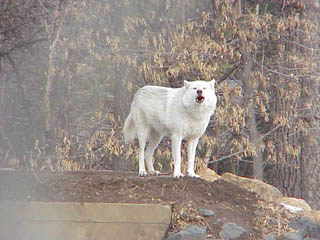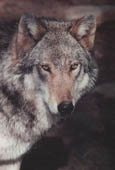
Photo (c) PSolfest, 1999
Wolf Communication

Wolf Communication
Wolves have a very special communication system which is of great importance to the social order of the pack. They need to be able to communicate with one another to coordinate activities like hunting or caring for pups. Wolves learn to communicate dominance, territory, aggression and friendliness to members of their pack and to other wolves. Wolves must possess a wide range of ways to communicate messages using facial expressions, eye contact, body posture, scenting and, of course, sounds.
Facial Expressions and Eye Contact
Wolves have a mask-like appearance,
with dark circles around the eyes surrounded by a lighter area and black
lips. All of these help to emphasize the expressions on a wolf's face.

When a wolf displays an aggressive
or dominant expressions, all parts of his body are forward. The
eyes stare directly ahead, the ears are standing up and pressed forward,
the corners of the lips are pushed forward and the hairs of the neck and
back (hackles) are raised. The teeth are bared. This combination
creates the impression of large size and aggressiveness and is intended
to intimidate an enemy.
A submissive expression is nearly the opposite. It involves, smoothing, flattening, and appearing restrained. The lips, for instance, are pulled back. The eyes look away. The ears are flat to the head. This makes the wolf look smaller and less threatening.
Photo credit: Ron Wulff Volunteer Wildlife
Reptile and Exotic Pet Rescue

Body Posture
The normal posture of a wolf is
relaxed with its tail hanging and a smooth expression. In friendly and
submissive postures, the wolf tries to look smaller. It may even
lie down or roll over. Aggressive postures are "puffed up", with
stiff legs and hair raised.
Aggressive Behaviors
Wolves will use posture and movements
to communicate to other wolves. A wolf may lay its chin or paws on the
back of another wolf to show dominance. It may lunge and snap at another
wolf or run at the wolf, slamming into its body. It may even jump high
into the air ending in a "body bash." The other wolf is supposed to run
away from this charge. These behaviors allow the wolf to express a strong
message with little damage to the other wolf.
Photo (c) PSolfest, 1999
Play Behaviors
A wolf that tries to get another
to play will raise its front paws and wag its tail. Play is an important
part of wolf activity. It helps to maintain social contact and is useful
for establishing relationships. Play can also hide some aggression. Play
behavior can become more aggressive as it continues. Play can also be used
by wolves to lessen aggression.
Submissive Behaviors
A wolf demonstrating submission
will have a crouched, low body posture, appearing to crawl. It looks like
the wolf is creeping forward, moving its hips from side to side as it does
so. The tail is low, often between its legs. It may raise its front paws
as if to play. A submissive wolf will roll over exposing its stomach to
the dominant wolf as a way to signal helplessness and lack of aggression.
Scenting
A wolf's sense of smell is so
sensitive that it can smell prey a mile away. Wolves use this strong sense
of smell for identification. Each wolf has its own unique smell that allows
other pack members to recognize it. Wolves also use urine and scat to mark
the borders of their territory. The scent lasts up to three weeks. These
signs warn other wolves away.
Howling

To see a wolf howl, click here.
Howling is a long distance way
for wolves to communicate. On a clear night, humans can hear a wolf howl
from four to ten miles away. Wolves have incredibly good hearing. They
are also able to turn their ears from side to side which allows them to
tell the direction from which a sound is coming. So, wolves can use their
howls to communicate with other members of their pack throughout a territory
of over one hundred miles.
Wolves also howl more often near the borders of their territory. They even seem able to howl in such a way as to sound like more than one animal. Thus howling seems to be an important part of keeping other wolves out of the pack's territory. One kind of howl is the howl to assemble. It may be used by the alpha wolf to call the other wolves together.
There is also a "chorus howl" which is begun by one wolf and then joined in by others. It is accompanied by tail wagging and face nuzzling and may take place for pure enjoyment. It adds to the social contact among the pack members.
Finally, there is the "lonesome howl". It is made by a single wolf that has become separated from the rest of the pack. Wolves in captivity have been heard to make this howl when another wolf has been removed from the area and also when a pup has died.
Despite the common belief, wolves ordinarily don't howl while hunting. They rely on stealth and silence to hunt.